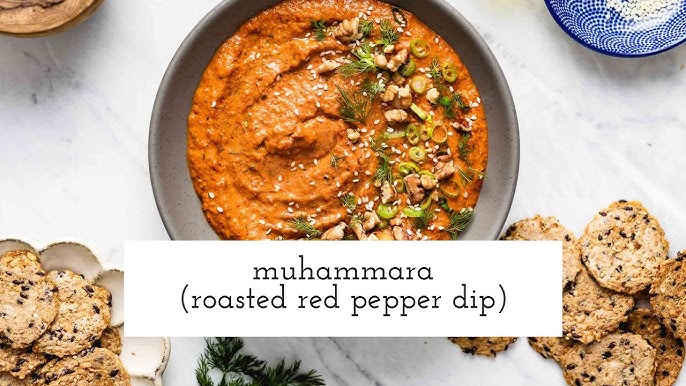Muhammara Recipe: Muhammara is a rich, smoky, slightly sweet, and mildly spicy red pepper dip originating from the Levantine region, particularly Syria. This vibrant dish has become popular across the Middle East and the Mediterranean, thanks to its bold flavor profile and versatility. Made with roasted red peppers, walnuts, olive oil, breadcrumbs, garlic, lemon juice, and pomegranate molasses, Muhammara boasts a unique taste that’s earthy, nutty, tangy, and spicy all in one bite.
Imagine dipping a piece of warm pita bread into a creamy, velvety spread bursting with flavor—that’s Muhammara in a nutshell. It’s a go-to appetizer for many, served at dinner parties, mezze platters, or simply as a snack. What sets Muhammara apart is its perfect balance of ingredients, offering a sensory experience that’s both comforting and exciting.
Origin and Cultural Significance
Hailing from Aleppo, Syria, Muhammara holds a special place in Levantine cuisine. In Arabic, the word “Muhammara” means “reddened,” referring to the dip’s signature red hue from the roasted peppers and Aleppo chili flakes. Over time, this dish has transcended borders, becoming a beloved staple in Lebanese, Turkish, and broader Mediterranean kitchens.
In Middle Eastern culture, food is more than sustenance—it’s about family, tradition, and hospitality. Muhammara is often prepared during festive gatherings and religious celebrations. Each family has its twist—some add cumin, others throw in a handful of spicy chili, and a few swap out walnuts for almonds or cashews. But the essence remains unchanged: it’s a communal dish meant to be shared and enjoyed.
Ingredients for Muhammara
Main Ingredients
To make authentic Muhammara, you need just a handful of wholesome ingredients. Here’s what you’ll need:
- Roasted Red Bell Peppers: The foundation of the dip, these provide sweetness and depth.
- Walnuts: Give the dip its creamy texture and nutty undertones.
- Breadcrumbs: Traditionally used for thickening; stale bread or panko also works.
- Garlic: Adds that essential pungent kick.
- Olive Oil: Helps emulsify and enrich the mixture.
- Pomegranate Molasses: Offers a tangy sweetness that balances the peppers.
- Lemon Juice: Brightens the overall flavor.
- Aleppo Pepper (or Red Chili Flakes): Adds spice and authentic regional flair.
- Salt and Pepper: Essential seasoning to bring it all together.
Every ingredient plays a role in creating the perfect harmony of flavors. High-quality, fresh components make a noticeable difference.
Optional Add-ons and Variations
While the classic Muhammara recipe is divine on its own, some people like to experiment. Here are some popular variations:
- Cumin: A touch of ground cumin adds an earthy warmth.
- Smoked Paprika: Enhances the smokiness.
- Tahini: Adds creaminess and a sesame note.
- Chili Paste: For those who prefer a spicier kick.
- Roasted Tomatoes: Offer an extra layer of umami.
Vegetarians and vegans adore this dish because it naturally contains no animal products. Plus, it’s gluten-free if you skip the breadcrumbs or use a gluten-free alternative.
How to Roast Red Peppers for Muhammara
Oven Roasting Method
Roasting red peppers is easy and totally worth it. The key to perfect Muhammara is getting those peppers nicely charred. Here’s how you can do it in the oven:
- Preheat your oven to 450°F (230°C).
- Wash and dry the red bell peppers thoroughly.
- Place them on a baking sheet lined with foil.
- Roast for about 25-30 minutes, turning occasionally, until the skin is blistered and blackened.
- Remove from the oven and transfer the peppers to a bowl covered with plastic wrap or a sealed bag. Let them sit for 10-15 minutes to steam. This makes peeling easier.
- Peel off the charred skin, remove the seeds, and set aside.
This method yields smoky, tender peppers that are perfect for blending.
Stovetop Roasting Method
No oven? No problem. The stovetop method works just as well:
- Place the whole peppers directly on a gas burner over medium flame.
- Turn them with tongs every few minutes until all sides are blackened.
- Transfer to a bowl and cover to steam.
- Peel, seed, and you’re done!
You can also use store-bought roasted red peppers, but the flavor won’t be as intense or fresh.
Step-by-Step Muhammara Recipe
Step 1 – Gathering the Ingredients
Start by laying everything out. Having your ingredients prepped and measured makes the process smoother. Make sure the peppers are already roasted and peeled, and that your garlic is fresh—not from a jar. Toast the walnuts lightly in a dry pan for 3-5 minutes to deepen their flavor.
Step 2 – Preparing the Ingredients
Roughly chop the peppers and walnuts for easier blending. Squeeze your lemon juice, measure out the molasses and spices, and get your breadcrumbs ready. This is the stage where you want to make sure each element is clean, fresh, and ready to shine.
Step 3 – Blending Everything Together
Now that your peppers, nuts, and other ingredients are prepped, it’s time to bring them together into a silky, flavorful dip. This is where the magic happens.
- Choose your blending method: A food processor works best, but a powerful blender will also do.
- Layer the ingredients:
- Start with chopped roasted peppers.
- Add toasted walnuts and breadcrumbs.
- Include garlic cloves, pomegranate molasses, lemon juice, and olive oil.
- Sprinkle in Aleppo pepper (or red chili flakes), salt, and black pepper.
- Pulse gently: Begin with short pulses to break everything down. This helps avoid overprocessing.
- Scrape down the sides: After a few pulses, stop and scrape the bowl to ensure everything blends evenly.
- Blend to taste:
- For a chunkier texture, blend until just combined.
- For a smooth, spreadable dip, blend for 30–45 seconds until silky.
- Add a bit of extra olive oil or a splash of water if it’s too thick.
The result should be thick, lush, and beautifully reddish-brown. Taste and add extra salt, lemon juice, or molasses as needed to balance the flavors.
Step 4 – Adjusting Texture and Flavor
Muhammara is all about balance. Taste it carefully and make tweaks to your liking.
- Too thick? Stir in a teaspoon of olive oil or a little water to loosen it up.
- Too sweet? Squeeze in more lemon juice or a tiny dash of vinegar.
- Not tangy enough? Add extra pomegranate molasses or lemon.
- Want more heat? Sprinkle in more Aleppo pepper or some cayenne.
- Missing richness? Drizzle extra-virgin olive oil over the top
- More nuttiness? Add a few more toasted walnuts and pulse briefly.
Adjusting in small increments and tasting as you go ensures you hit your ideal flavor profile without over-adjusting.
Serving Suggestions
Muhammara is versatile and can be served in many creative ways:
- As a Mezze Dip: Pair with warm pita, flatbread, or veggie sticks (carrots, cucumbers, bell peppers).
- With Grilled Meats: Serve as an accompaniment to kebabs, chicken, or even fish.
- Sandwich Spread: Slather on sandwiches or wraps for a flavor upgrade.
- With Eggs: Dollop onto hard-boiled, scrambled, or fried eggs.
- On Toast or Crackers: Enjoy as an open-faced snack with toppings like feta, olives, or roasted veggies.
- As a Pasta Sauce: Stir it into pasta or use it as a pizza base to bring Mediterranean flair.
Finish with a drizzle of olive oil, a sprinkle of chopped parsley or mint, and optional toppings like crumbled feta, pomegranate seeds, or ground sumac.
Storage and Shelf Life
Here’s how to keep your dip fresh and delicious:
Refrigerating:
- Transfer to an airtight container.
- Store in the fridge for up to 5–7 days.
- Before serving, drizzle some olive oil over the top to prevent drying and refresh the flavors.
Freezing:
- Spoon into a freezer-safe container or ice cube tray (for single servings).
- Freeze for up to 3 months.
- Thaw in the fridge overnight and stir before using.
Nutritional Benefits of Muhammara
Muhammara isn’t just tasty—it’s nutritious too:
- Roasted Red Peppers: High in vitamins A & C, antioxidants, and fiber.
- Walnuts: Loaded with healthy omega-3 fatty acids, protein, and fiber.
- Olive Oil: Rich in monounsaturated fats and anti-inflammatory polyphenols.
- Pomegranate Molasses: Contains antioxidants and natural sweetness without refined sugar.
- Garlic and Spices: Offer immune-boosting and anti-inflammatory properties.
A 2-tablespoon serving typically offers around:
- Calories: 100–130 kcal
- Fat: 8–10 g (mostly healthy fats)
- Protein: 2–3 g
- Carbs: 5–7 g (mostly fiber and a bit of natural sugars)
It’s perfect as part of a heart-healthy, Mediterranean-style diet—rich in plant-based proteins and anti-inflammatory nutrients.
Common Mistakes to Avoid
Be sure to sidestep these pitfalls:
- Skipping Roasting: Using raw peppers won’t give you the depth and smokiness you need.
- Not Toasting the Nuts: Toasting brings out the full nutty flavor.
- Over- or Under-Blending: Blend gradually to reach your preferred consistency.
- Ignoring Balancing: Always taste and tweak salt, acid, sweetness, and heat—one bite transforms the entire flavor profile.
- Using Low-Quality Oils: Extra-virgin olive oil makes a big difference in richness.
- Foregoing Breadcrumbs: Skip them only if you’re adapting for gluten-free—otherwise they help create better texture.
FAQs about Mug Cookie Recipe
Can I make a mug cookie without eggs?
Absolutely! Most mug cookie recipes skip eggs altogether to avoid overpowering the flavor and to keep things simple. You can use milk, yogurt, or even mashed bananas as a binder instead.
Can I use self-rising flour instead of all-purpose flour?
Yes, you can! Just skip the baking soda or baking powder if you’re using self-rising flour, as it already contains leavening agents.
How do I avoid a dry mug cookie?
To prevent dryness, don’t overcook it. Microwave your mug cookie in 30-second intervals and stop once it looks slightly gooey in the center — it’ll continue cooking in the mug.
Can I make a vegan mug cookie?
Of course! Use plant-based milk, vegan butter or coconut oil, and dairy-free chocolate chips for a delicious vegan version.
Is it safe to microwave cookie dough?
Yes, as long as the ingredients are meant to be cooked (no raw eggs or flour that hasn’t been heat-treated), it’s safe. The short cooking time in the microwave ensures a warm, edible treat in minutes.
Conclusion
Muhammara is a Mediterranean gem: smoky, sweet, tangy, and rich. Its versatility makes it a kitchen staple—whether for dips, spreads, sauces, or even dressings. Armed with this step-by-step guide, you’ll whip up a batch that’s vibrant, balanced, and utterly delicious every time!



